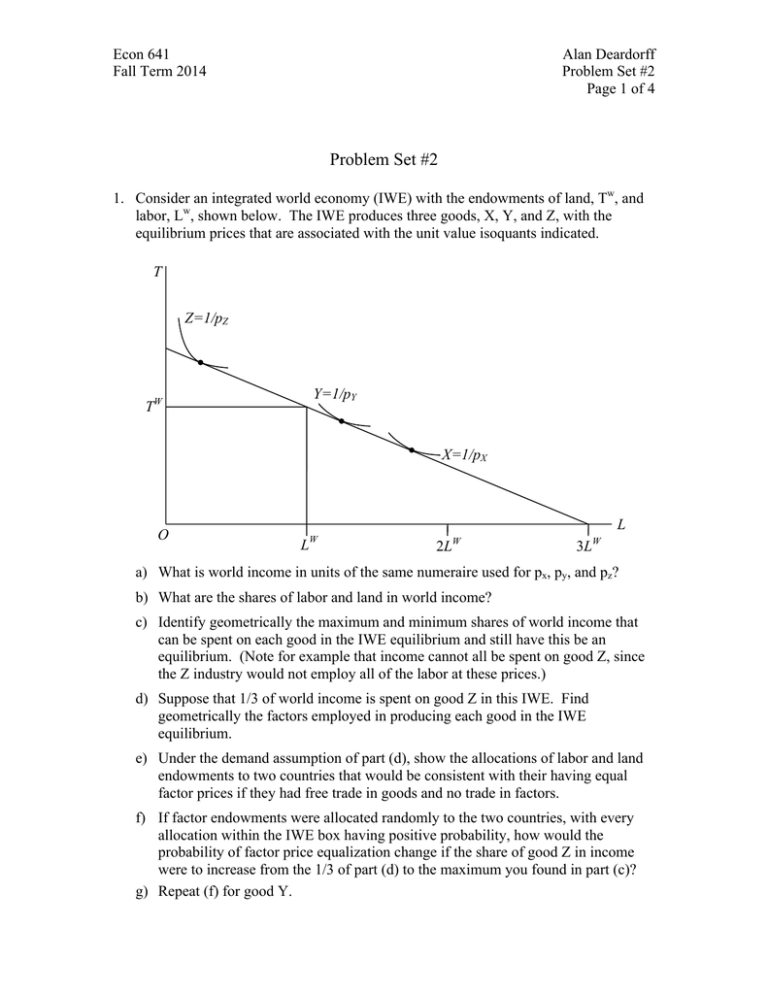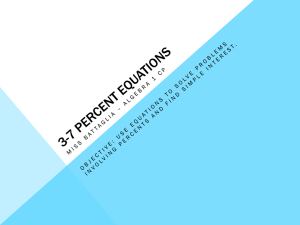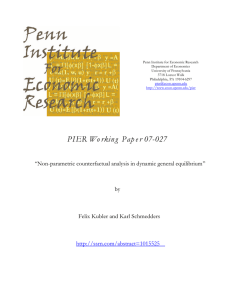Problem Set #2
advertisement

Econ 641 Fall Term 2014 Alan Deardorff Problem Set #2 Page 1 of 4 Problem Set #2 1. Consider an integrated world economy (IWE) with the endowments of land, Tw, and labor, Lw, shown below. The IWE produces three goods, X, Y, and Z, with the equilibrium prices that are associated with the unit value isoquants indicated. T Z=1/pZ Y=1/pY TW X=1/pX O L L W 2L W 3L W a) What is world income in units of the same numeraire used for px, py, and pz? b) What are the shares of labor and land in world income? c) Identify geometrically the maximum and minimum shares of world income that can be spent on each good in the IWE equilibrium and still have this be an equilibrium. (Note for example that income cannot all be spent on good Z, since the Z industry would not employ all of the labor at these prices.) d) Suppose that 1/3 of world income is spent on good Z in this IWE. Find geometrically the factors employed in producing each good in the IWE equilibrium. e) Under the demand assumption of part (d), show the allocations of labor and land endowments to two countries that would be consistent with their having equal factor prices if they had free trade in goods and no trade in factors. f) If factor endowments were allocated randomly to the two countries, with every allocation within the IWE box having positive probability, how would the probability of factor price equalization change if the share of good Z in income were to increase from the 1/3 of part (d) to the maximum you found in part (c)? g) Repeat (f) for good Y. Econ 641 Fall Term 2014 Alan Deardorff Problem Set #2 Page 2 of 4 2. Tests of the standard HOV Theorem, F i = V i − s iV W , require data on factor endowments of the entire world. This problem deals with a related result, due to Bob Staiger, that compares factor contents and endowments for only a pair of countries, and therefore requires data only on two countries. In a world of many countries, identical constant-returns-to-scale technologies, identical homothetic preferences, and factor price equalization, consider any two countries, A and B, and let FA and FB be the vectors of the factor contents of the net exports of each, both measured using the actual factor requirements in use in country A, AA. Thus F i = A AT i , i = A, B , where Ti is country i’s vector of net exports. a) Show that for any factor, k, if trade of both countries is balanced, then FkA FkB VkA VkB − = − YA YB YA YB where VA and VB are the countries’ vectors of factor endowments and YA and YB are their (scalar) incomes. b) Of the assumptions listed at the start of this question, which if any can be relaxed and still have the relationship in part (a) be valid? c) Suppose now that trade is not necessarily balanced. Can you derive a relationship analogous to that in part (a) that relates the factor contents of the two countries trade to their factor endowments using only data from the two countries themselves? d) Returning to balanced trade, suppose contrary to the above that factor k in country A is more productive in all uses than its counterpart in all other countries by a multiple λ. How must the assumptions and relationship in part (a) be modified in order to remain valid and still include, except for λ, only the same observable variables? 3. a) Does the “Friends and Enemies” version of the Stolper-Samuelson Theorem work for groups of goods? That is, with arbitrary numbers of n goods and m factors, suppose that pˆ i = ρ > 0 for all i in a group G of nG < n goods and pˆ i = 0 ∀i ∉ G . Is it then true that there must exist at least one factor, jF , such that ŵ jF > ρ and at least one other factor, jE, such that wˆ j E < 0 ? To keep things simple, assume that every factor is employed in positive amounts in every industry. b) Now suppose, again with arbitrary numbers of goods and factors, and all factors employed in strictly positive amounts in all goods, that prices change by amounts that are not all equal, so that at least some relative prices change. Can we be sure that at least one factor is made unambiguously better off and at least one factor is made unambiguously worse off? Econ 641 Fall Term 2014 Alan Deardorff Problem Set #2 Page 3 of 4 c) In parts (a) and (b) we found that wˆ jF > pˆ i ∀i & wˆ jE < pˆ i ∀i. Suppose that we are in the “Extreme Specific Factors Model” in which all factors are unable to move across industries. Why, in that model, does this conclusion not hold? What in the proofs of (a) and (b) prevents the argument from going through? Is it still true that owners of some factors unambiguously gain and owners of some factors unambiguously lose? 4. In the two-good Heckscher-Ohlin model, the Rybczynski Theorem says that, at fixed prices and with factor-price equalization, an increase in the endowment of (only) one factor will cause the output of one good to fall and output of the other good to increase by a larger percentage than the increase in the factor endowment itself. How many, if any, of these results are also valid in the two-good specific factors (RicardoViner) model? That is, a) Is it true for any factor that an increase in its endowment reduces the output of one good, and, if so, is this true for all factors? b) Is it true for any factor that an increase in its endowment increases the output of some good more than in proportion to the endowment increase, and, if so, is this true for all factors? 5. In the following modification of the Spence-­‐Dixit-­‐Stiglitz utility function, determine the value of the parameter ν that will neutralize the effect of increased variety on utility. That is, assuming that all varieties are priced the same, find the value of ν such that an increase in n, holding prices and total expenditure constant, will leave utility unaffected. 1 n ⎛ ⎞ U = ⎜ ∑ nν ciβ ⎟ ⎝ i =1 ⎠ β 6. Suppose a world of many countries, each like the countries modeled in Krugman (1979) but with labor endowments, Lj, that may be different. That is, consumers !! ! ! in country j maximize a utility function 𝑈! = !!! 𝑣 𝑐! where 𝑣 𝑐! is per capita consumption of the ith variety in country j, while nj firms, one for each ! ! ! ! variety i, produce a quantity 𝑥! = 𝐿! 𝑐! incurring a labor cost of 𝑙! = 𝛼 + 𝛽𝑥! with 𝛼, 𝛽 > 0. In equilibrium, firms charge prices pj that maximize their profits given outputs of other firms; the wage, wj, is determined to clear the labor ! ! market 𝐿! = !!! 𝑙! ; and free entry of firms drives profits to zero: ! ! ! ! 𝜋! = 𝑝! 𝑥! − 𝑤 ! 𝑙! =0. a) Following Krugman, suppose first that the v functions are such that v′>0, ! v′′<0, and 𝑑𝜀 𝑑𝑐! < 0 where ε is the (positive) elasticity of demand facing any firm as a function of its consumers’ per capita demand. Holding constant Econ 641 Fall Term 2014 Alan Deardorff Problem Set #2 Page 4 of 4 the world’s population, 𝐿! = ! 𝐿! , determine how the following variables depend on an individual country’s population, Lj. i) The ratio of the wage to any good’s price, wj/pj , in autarky. ii) The ratio of the wage to any good’s price, wj/pj , in free trade. iii) The gain in consumer utility of going from autarky to free trade. b) Now suppose instead that dε/dcj = 0. Which of your answers in part (a) are altered, and why?









